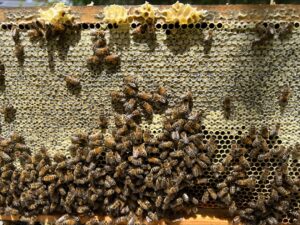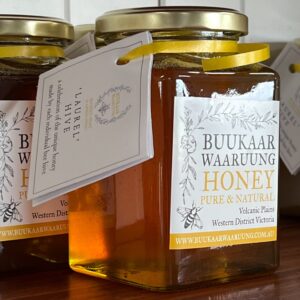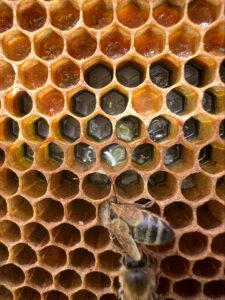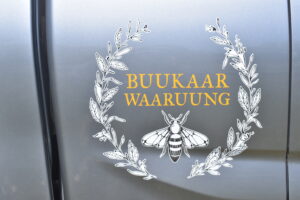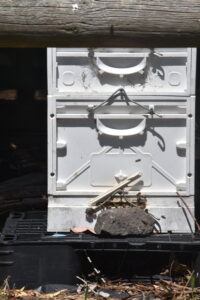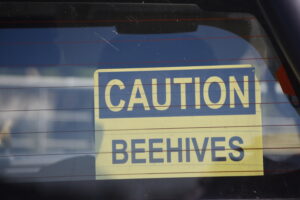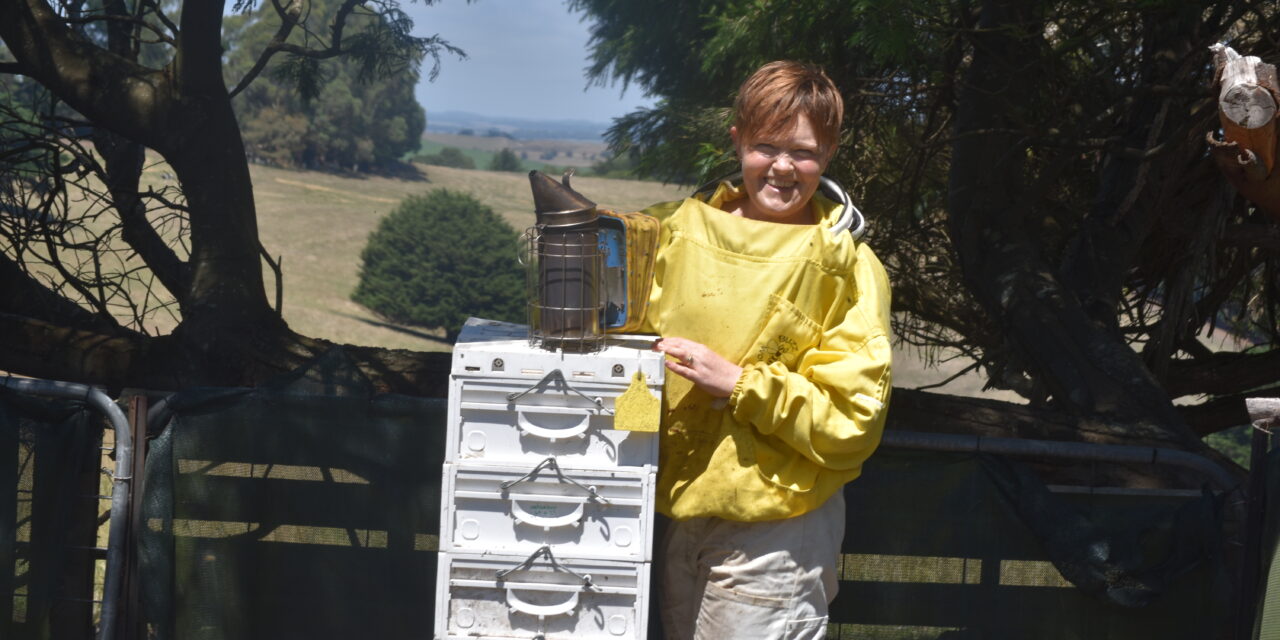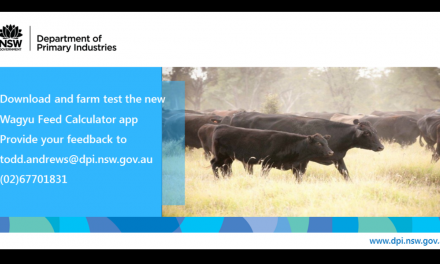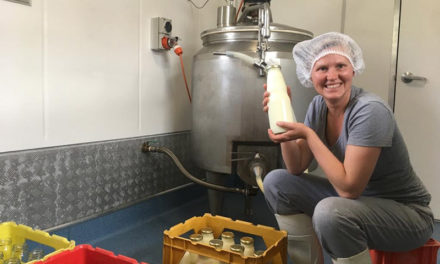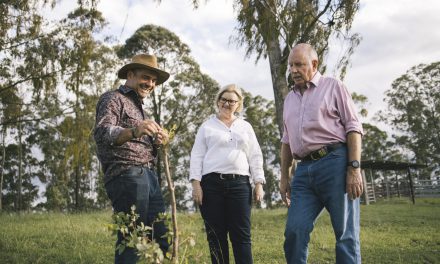Dr Anna Carrucan says beekeepers like a good pun and her small business is buzzing with them, as RICK BAYNE discovered.
A second-generation beekeeper with a PhD in botany, Anna has created four facets to her Buukaar Waaruung Boutique Apiary & Artisan Honey enterprise near Camperdown in south-west Victoria.
There’s Bee Sweet — the honey side of things; Bee Green — the botany side dealing with farms, gardens and pollination; Bee Keep — to do with hive management, mentoring and managing client hives; and Bee Spoke — giving talks at field days and farms walks and talks.
The four pillars make sure Anna is a busy bee with a hive of activity on the 25-hectare property she shares with her pharmacist husband Irwin.
Okay, so we’ve got the puns out of our system, let’s find out how a middle-aged woman with a PhD, as well as being a qualified teacher and educator and science communicator, came to be an apiarist.
It stems back to her childhood when her father Peter started keeping bees, something he continues at age 82.
“That’s where I got my beekeeping interest from,” she said.
Inspired by a beekeeping book given by his wife Joy as a present, Peter acquired bees when Anna was primary student, and kept them on their 4ha property at Woodford, north of Warrnambool.
Even though she didn’t interact directly with her father’s hives, having them around sparked her interest.
“Unlike now, you couldn’t buy kids’ size bee suits so I didn’t work on the hives but I helped with harvesting and bottling honey,” Anna said.
“I was more interested in the biology of the bees rather than just for honey.”
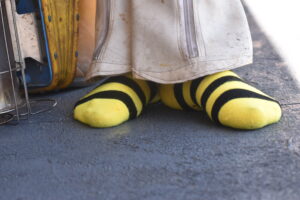
Anna Carrucan embraces the image of a beekeeper, right down to her socks.
About 12 years ago, Anna decided she wanted a hive, and despite his warnings that they’re a lot of work, Peter relocated one of his hives.
Anna had worked as an academic tutor at University of Melbourne and as a senior ecologist for Greening Australia, but felt the call of the country life and relocated to near Camperdown in 2007.
The bees had been a hobby in the background and one hive became four and then six, but most were wiped out when the property was burnt in the 2018 St Patrick’s Day fires. (Only the house and a small patch of grass were spared. A peat wetland took months to extinguish.)
After losing her job that July as part of a series of redundancies, Anna was faced with seeking a new job, taking a break, or growing the bee business.
The bees won.
“I decided to have a go of making something from the bees focused around not just having hives and selling honey but bringing in my science and education background to encompass all things bees.”
Truly embracing the field, Anna became editor of the Australasian Bee Keeper magazine and also managed a pollinator project for the Wheen Bee Foundation, producing brochures to enhance gardens to attract and support native pollinators.
Beekeepers keep European honey bees but Anna says we need to do more to support native bees, even if they don’t produce high quantities of honey.
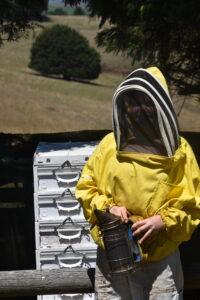
Being fully covered is part of the job, but bees still occasionally manage to break through and sting.
Anna has been stung “countless” times despite always wearing protective gear.
“If I’m working for a whole day on the hives, I might get one or two stings, I might get none. It depends on the hives and on the weather … storms make them a bit feisty.
“I’m less reactive than I used to be but because I’m working solo, I have a first aid kit with me as a precaution.”
With the editor and project management roles, Anna has downscaled from a peak of 50 to 30 hives.
“It’s niche as far as beekeeping operations go; it’s not mechanised and it’s a one-person operation.”
She doesn’t migrate her bees, instead housing them on sites around Camperdown that have diverse year-round food sources.
“A bee hive is like having a sheep station in a cubic metre.”
Bees are considered livestock and keepers must be registered and follow animal welfare and biosecurity requirements.
Anna says prospective keepers need to educate themselves before investing in a hive.
“I picked up the basics from Dad,” she said.
“It was good to have that hands-on help to recognise the components of the hive equipment, interpret what you see and spot the queen bee.
“Over time I’ve added to that by reading quality books on the next level of beekeeping, and learning from bee research scientists, too.”
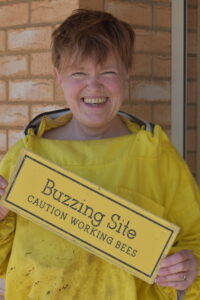
Beekeeping is becoming more popular around Victoria and Anna Carrucan mentors people entering the industry.
For at least nine months of the year, she’s kept busy.
Spring is peak season for swarming and Anna has to inspect and manage the hives to keep space for the queen to lay eggs, and feed the bees with a sugar syrup solution or pollen substitutes if the season has been hard.
“If it has been really cold over winter and bees are not getting out, it can be a disaster and feeding is necessary.
“Bees keep their hives around 33 degrees so you can’t open them and do hive inspections on cold and windy days.”
By January, swarm impulse has dropped off and the bees switch to honey storage and production, meaning Anna has to manage space for honey storage, taking some off and bottling it.
During autumn she looks at how much honey the bees will need as they get to the end of the good foraging weather.
Winter jobs involve getting ready for spring — waxing new frames, cleaning the smoker, catching up on project work, checking for storm damage, ensuring they’re safe from livestock and are not running out of food.
Backyard beekeeping has grown in popularity over the past decade, particularly since the introduction of the Flow hive, an invention that lets beekeepers put a tool in each frame allowing the honey to leak out a tube into a jar.
There are 19 registered beekeepers in the Camperdown region, mostly backyarders.
In Victoria there are more than 11,000 registered beekeepers managing a total of 135,000 hives — the majority are hobby beekeepers with a hive or two in their garden.
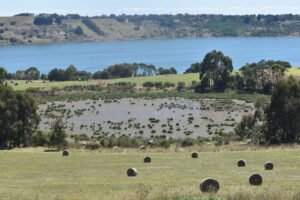
The 25-hectare property is now used mostly for growing hay and silage.
The Buukaar Waaruung property overlooks Lake Gnotuk.
Apart from a handful of hives, the land is used for hay and silage. It was previously grazed by cattle but they changed to a more conservation-focused land management model, reducing their time commitment and fertiliser and herbicide use, and removing nutrient from the property to improve soil health.
In the Bee Sweet part of her business, Anna sells honey in local boutique cafes and providores.
She says she likes bees and working with the hives “99 per cent of the time”.
“I enjoy observing their body language and seeing the dynamics of the hive as you open it up and the different things the hive is telling you about the health and wellbeing of the bees.
“I also like the autonomy of beekeeping but it is something you need to be self-motivated to do.
“It was a total sideways move and it still uses my academic, science-curious brain and my botany background … but I do enjoy peeling off the sweaty bee suit at the end of the day.”
